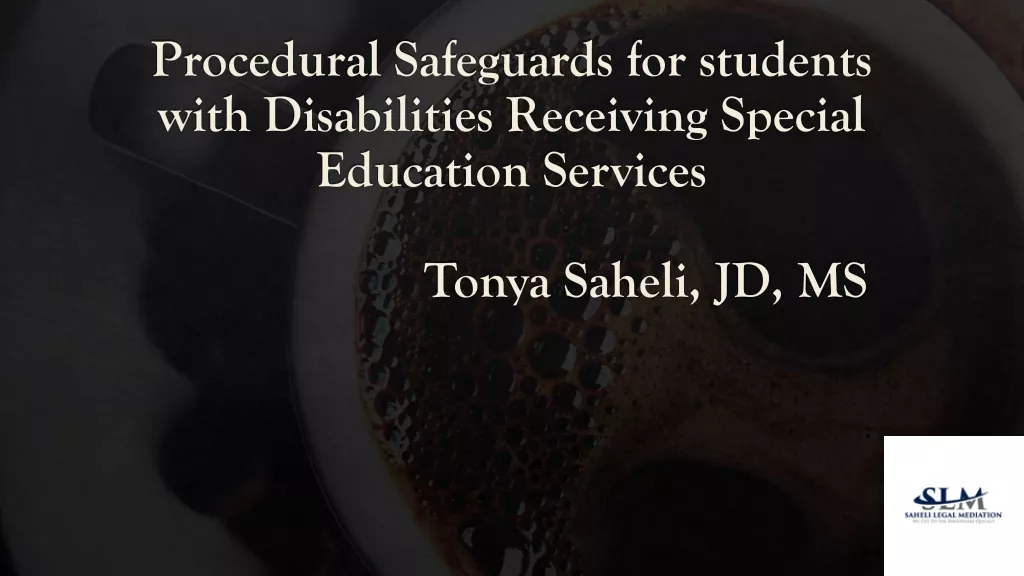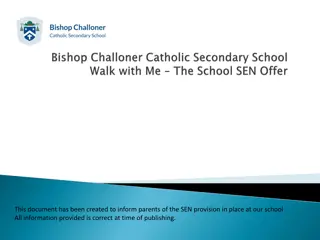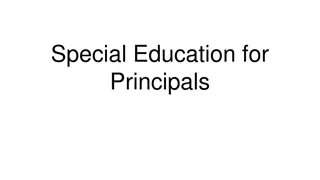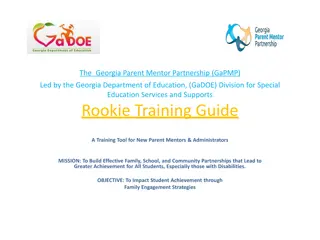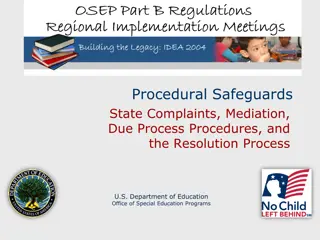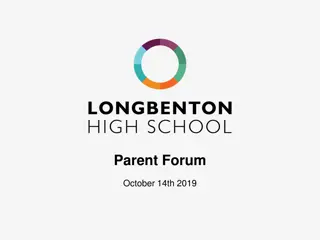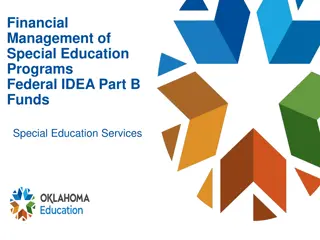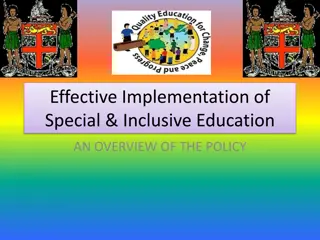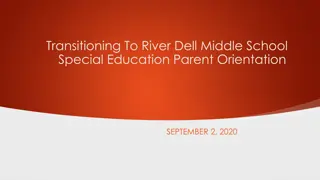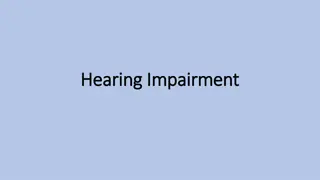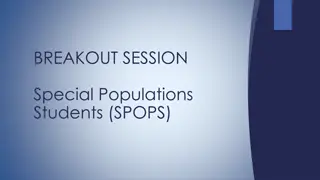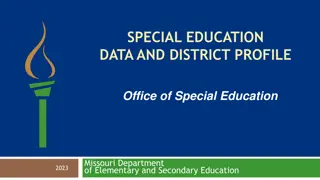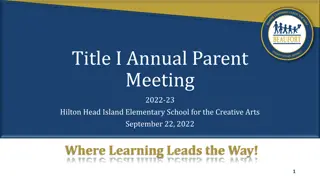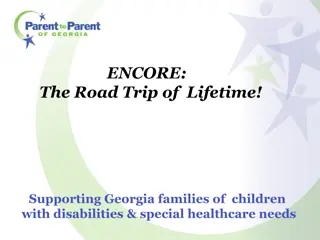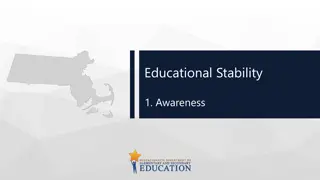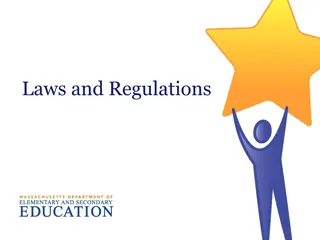Understanding Educational Surrogate Parent for Students with Special Education Services
Ensuring rights and protection for students with special education needs, educational surrogate parents play a crucial role in representing children in various educational matters. Learn about the responsibilities, significance, and key aspects of special education services under IDEA 2004.
Download Presentation

Please find below an Image/Link to download the presentation.
The content on the website is provided AS IS for your information and personal use only. It may not be sold, licensed, or shared on other websites without obtaining consent from the author. Download presentation by click this link. If you encounter any issues during the download, it is possible that the publisher has removed the file from their server.
E N D
Presentation Transcript
EDUCATIONAL SURROGATE PARENT FOR A STUDENT WITH SPECIAL EDUCATION SERVICES 1
WHICH STUDENTS NEED AN EDUCATIONAL SURROGATE PARENT? IDEA 300.519 Surrogate parents. (a) General. Each public agency must ensure that the rights of a child are protected when (1) No parent (as defined in 300.30) can be identified; (2) The public agency, after reasonable efforts, cannot locate a parent; (3) The child is a ward of the State under the laws of that State; or (4) The child is an unaccompanied homeless youth as defined in section 725(6) of the McKinney-Vento Homeless Assistance Act (42 U.S.C. 11434a(6)). 2
EDUCATIONAL SURROGATE PARENT RESPONSIBILITIES IDEA 300.519 Surrogate parents. (g) Surrogate parent responsibilities The surrogate parent may represent the child in all matters relating to (1) The identification, evaluation, and educational placement of the child; and (2) The provision of FAPE to the child. Students with situations listed in (a) who are in referral to special education have a right to an educational surrogate parent. Students with situations listed in (a) who are enrolled in special education have a right to an educational surrogate parent. 3
WHAT IS SPECIAL EDUCATION? The purpose of the Individuals with Disabilities Education Improvement Act (IDEA 2004) is to ensure that all children with disabilities have available to them a free and appropriate public education (FAPE) that emphasizes special education and related services designed to meet their unique needs and prepare them for further education, employment, and independent living. The term special education means specially designed instruction to meet the unique needs of a child with a disability. 4
WHAT ARE THE PROCEDURAL SAFEGUARDS ? Procedural Safeguards refers to the rights and privileges afforded to students with disabilities and their parents. The school must provide you with Notice of Procedural Safeguards, Rights of Parents of Students with Disabilities only one time a year with the following exceptions: at the time of initial referral, parental request for evaluation, the first occurrence of the filing of a complaint, disciplinary actions, and at your request. Weblinks: Procedural Safeguards English Companion Document Translated Procedural Safeguards Spanish Vietnamese Somali Mandarin Khmer French Arabic 5
RESPONSIBILITIES OF AN EDUCATIONAL SURROGATE? The educational surrogate parent should interact with the school in the same manner that a parent would. Visit the student and the student s school on a regular basis. Consult with persons involved in the student s education. Review the student s educational records. Attend IEP meetings. Exercise independent judgement in pursuing the student s interests. Exercise the student s due process rights, when appropriate. 6
YOU, as the parent, are the only one authorized to consent to the following: Conduct any re-evaluation Consent for initial provision of special education and when appropriate, related services Change placement Release educational records For those students that are in DHHS custody, the caseworker is NOT able to consent to these things. IMPORTANT 7
SPECIAL RULES FOR INITIAL EVALUATION OF WARDS OF THE STATE Parental Consent - 34 CFR 300.300 If a child is a ward of the State and is not living with his/her parent The SAU does not need consent from the parent for an initial evaluation to determine if the child is a child with a disability if: 1. Despite reasonable efforts to do so, the SAU cannot find the child s parent; 2. The rights of the parents have been terminated in accordance with State law; or 3. A judge has assigned the right to make educational decisions and to consent for an initial evaluation to an individual other than the parent. Ward of the State, as used in the IDEA, means a child who, as determined by the State where the child lives, is: 1. A foster child; 2. Considered a ward of the State under State law; or 3. In the custody of a public child welfare agency. DEVELOPED BY THE PARENT COORDINATION NETWORK - REGION 9 ESC - UPDATED OCTOBER 2013 8
ELIGIBILITY FOR SPECIAL EDUCATION There are 2 parts for determining whether a student is eligible for special education services: (1) the student must have a disability, AND (2) as a result of the disability, the student must need special education services to benefit from education (adverse effect). 9
If the student is struggling. The school must: Provide Interventions Response to Intervention (RTI), accommodations, other interventions to help the student make progress. If this isn t successful, a referral for special education should be made. The student should have a series of evaluations. The IEP Team (which includes a parent or educational surrogate parent) meets and reviews the evaluation results to determine if the student is eligible based on educational needs. STEPS TO ELIGIBILITY 10
REFERRAL FOR EVALUATION The school or parent may request an evaluation of the student when a disability is suspected (No ESP is assigned before referral.). A parent may directly ask for an evaluation for special education services. A parent may begin this process of referral by indicating in writing to the teacher or administrator that he or she believes that the student is in need of special education services. A school district has a duty to make a referral for an evaluation for special education services anytime it suspects that a student has a disability and a need for special education services under the Individuals with Disabilities Education Act (IDEA). If targeted interventions were tried and the student has not progressed as expected, or the student requires services beyond what is available in general education, the student may have a disability and a need for special education services. 11
REFERRAL FOR EVALUATION The school must obtain prior written consent from the parent (unless a ward of the State) before conducting the initial evaluation to determine if the student has a disability and needs special education services. The initial evaluation for special education is to be done within 45 school days of receiving the signed written consent for evaluation. (c) Consent for wards of the State (i) In general. If the child is a ward of the State and is not residing with the child s parents, the SAU shall make reasonable efforts to obtain the informed consent from the parent (as defined in 20 USC 1402) of the child for an initial evaluation to determine whether the child is a child with a disability. (ii) Exception. For initial evaluations only, if the child is a ward of the State and is not residing with the child s parent, the SAU shall not be required to obtain informed consent from the parent of a child for an initial evaluation to determine whether the child is a child with a disability if: (I) Despite reasonable efforts to do so, the agency cannot discover the whereabouts of the parent of the child; (II) The rights of the parents of the child have been terminated in accordance with State law; or (III) The rights of the parent to make educational decisions have been subrogated by a judge in accordance with State law and consent for an initial evaluation has been given by an individual appointed by the judge to represent the child. [34 CFR 300.300(a)(2)] 12
REFERRAL FOR EVALUATION The initial evaluation must be conducted within 60 calendar days of receiving parental consent for the evaluation for students in the Child Development Services System, or within 45 school days of receiving parental consent for the evaluation for students 5-20 years of age under the responsibility of the public school system, and must consist of procedures to determine if the student is a child with a disability and to determine the educational needs of the student. The evaluation must be conducted by a team of qualified professionals and include parent (your and/or DHHS caseworker) input. After the evaluation is complete the IEP team will meet to determine if the student requires special education services. 13
REEVALUATION MUSER V. 1. B. (2) A reevaluation shall occur: (a) Not more frequently than once a year, unless the parent and the local educational agency agree otherwise; and (b) At least once every 3 years, unless the parent and the local educational agency agree that a reevaluation is unnecessary. DEVELOPED BY THE PARENT COORDINATION NETWORK - REGION 9 ESC - UPDATED OCTOBER 2013 14
The school will use a variety of assessment tools and strategies to gather relevant functional, developmental, and academic information, including information provided by persons with knowledge or expertise that may assist in determining whether the student is a student with a disability; and the content of the student s IEP (Individual Education Program), including information related to enabling the child to be involved and progress in the general education curriculum. EVALUATION DATA AND HOW IT IS USED 15
Tests of intelligence Tests of achievement level Psychological tests Tests of the student s speech/language abilities Medical evaluations Grades Conduct reports Information from teachers Information from parent (you) EVALUATION DATA MAY INCLUDE 16
Ask questions. Understand what the conclusions and recommendations are. WHAT SHOULD I DO? Understand why those conclusions and recommendations are being made. If you disagree with the school s evaluation, you have the right to obtain an Independent Educational Evaluation (IEE). 17
Upon completion of the evaluation, and if the student is found to be a student with a disability, you will be asked to give consent for special education services and placement. CONSENT If you refuse to consent to services, the local education agency shall not provide special education and related services to the student. 18
The IEP team determines a students eligibility to receive special education services and develops the individualized education program (IEP) of the student. IEP team meets at least once a year to review the student s IEP and determine whether the annual goals are being met and to determine what goals, accommodations and modifications will be needed for the coming year. IEP TEAM AND MEETING Each student has their own IEP team. Develops, reviews, revises the student s Individualized Education Program (IEP). Develops annual goals and objectives for the student and determines least restrictive environment. 19
Selects appropriate accommodations or curriculum modifications for the student. Determines the student s placement. IEP TEAM AND MEETING Determines the appropriate state assessment for the student. Determines the specific services the student needs. Changes to a student s IEP, after the annual IEP meeting may be made without convening an IEP meeting if you agree. The school will amend the current IEP and provided you a copy of the amended IEP. 20
THE SCHOOL MUST GIVE YOU NOTICE OF AN IEP MEETING AT LEAST SEVEN SCHOOL DAYS BEFORE THE MEETING. AND MAY HOLD A MEETING WITHOUT A PARENT THE MEETING IS TO BE HELD AT A TIME AND PLACE MUTUALLY AGREEABLE TO YOU AND SCHOOL OFFICIALS. YOU CAN ASK FOR AN IEP MEETING WHENEVER YOU BELIEVE IT IS NEEDED. REMEMBER, THAT MANY PROBLEMS OR CONCERNS CAN BE HANDLED OUTSIDE OF THE IEP PROCESS (E.G., IN A PARENT CONFERENCE.) 21
YOU are an active part of the team. YOU are vital to this process. WHAT IS MY ROLE IN THE IEP PROCESS? Review the information presented to the team Ask questions. YOUR job is to make sure that the student is getting all of the services that he/she needs. In terms of educational decisions, YOU are the parent! If you have questions, ask. If you want clarification, ask. If you need more information, ask. You should be ready to: If you disagree with proposals being made, speak up, Let the school know why you disagree and what you would like done to remedy the problem. 22
Teachers (general and special education) Persons knowledgeable about any evaluation data Administration representative THE IEP TEAM ALSO INCLUDES: Other persons who may be helpful to the committee You, as the educational surrogate parent The student should be invited to attend Adult student o The adult student may invite his/her former educational surrogate parent (you) or anyone else to attend the meeting to assist him/her. 23
REQUIREMENTS OF THE INDIVIDUALIZED EDUCATION PROGRAM (IEP) The student s strengths, needs and present levels of academic and functional performance. Annual goals, both academic and functional goals, including how the student s progress will be measured and reported to you. Description of special education and related services to be provided, including frequency, duration and location. This should also include extended school year services if necessary. Discussion about Least Restrictive Environment (LRE). Supplementary aids and services to be provided. Program modifications and supports. Discipline if warranted. Transition Services. 24
Least Restrictive Environment refers to the placement or instructional arrangement in which the student is served. Students with disabilities have a right to be educated in the least restrictive environment and have access to the general education curriculum. WHAT DOES LEAST RESTRICTIVE ENVIRONMENT (LRE) MEAN? The IEP team decides on the student s placement. More restrictive means less contact with non- disabled students. 25
SPECIAL FACTORS The IEP team may need to address the following special factors for some students. Behavior Communication Limited English Proficiency Opportunities for direct communications with peers and professional personnel in the student s language and communication mode Appropriate reading and writing media and an evaluation of the student s future needs for instruction in Braille Assistive Technology Autism 26
The need for the particular services is demonstrated by means of: (a) A review by the child s IEP Team of relevant information including, but not limited to, progress reports and relevant assessments, parent report, observations or documentation; (b) Consideration by the child s IEP Team of the significance of the child s disability, progress toward IEP goals; and (c) Consideration of the impact of previous service interruptions, if applicable, and the probability that the child is unable to recoup, in a reasonable amount of time, skills previously mastered. EXTENDED SCHOOL YEAR SERVICES MUSER 2. A. (7) 27
AT THE CONCLUSION OF THE MEETING The IEP Team should work toward consensus, but the SAU has ultimate responsibility to ensure that a child is appropriately evaluated; that the IEP includes the services that the child needs in order to receive FAPE; and that the child s placement is in the least restrictive educational placement. It is not appropriate to make evaluation, eligibility, IEP or placement decisions based upon a majority vote. If the team cannot reach consensus, the SAU must provide the parents with prior written notice of the school s proposals or refusals, or both, regarding their child s educational program, and the parents have the right to seek resolution of any disagreements by initiating an impartial due process hearing or a State complaint investigation. ***************** The school must give you prior written notice at least 7 days prior to the date that the school proposes or refuses to initiate a change in your student s program, unless you waive your right to notice. They must provide a copy of the new IEP within 21 schools day of the meeting. 28
WHAT IS MY ROLE IN THE IMPLEMENTATION OF THE IEP? The school district and its personnel have the responsibility to implement and follow the IEP as it is written. If you have reason to suspect the IEP is not being properly implemented, express your concerns to the school. If your concerns are not addressed appropriately, review the Procedural Safeguards for more information. 29
AM I DOING WHAT I AM SUPPOSED TO? Ask yourself Would I be making the same decision and recommendations that would make for your own child? AND Will this decision and/or recommendation benefit the student? 30
School officials may remove a student from the placement if the student violates the code of conduct. This removal can be to an appropriate interim alternative educational setting, another setting, or suspension. DISCIPLINE FOR STUDENTS WITH SPECIAL NEEDS The authority of school officials to order such a removal is limited to no more than ten consecutive school days, except for special circumstances/situations. In ordering the removal of a student with a disability, school officials must apply the same standards and follow the same procedures that apply to the general education student. 31
MANIFESTATION DETERMINATION If a student violates the student code of conduct, and the school is recommending a change of placement, within 10 school days, the IEP team must convene and determine if the student s conduct was caused by direct and substantial relationship to the student s disability, or a direct result of the school s failure to implement the IEP. (Manifestation Determination) 32
A school is permitted to remove a student with a disability to an alternative educational setting for not more than 45 calendar days without regard to whether the behavior is determined to be caused by the student s disability, in cases where a student: Carries or possesses a weapon at school, on school premises, or at a school function Knowingly possesses or uses illegal drugs, or solicits the sale of controlled substance, while at school, on the school premises, or at a school function. Has inflicted serious bodily injury upon another person while at school, on school premises, or at a school function. ALTERNATIVE EDUCATIONAL SETTING 33
Beginning not later than the first IEP to be in effect when the student is 16 or 9th grade, which ever comes first, and updated annually thereafter, the IEP must include: Appropriate measurable post-secondary goals based upon age-appropriate transition assessment related to training, education, employment, and independent living skills, where appropriate; Transition services needed to assist the student in reaching those goals, including courses of study. TRANSITION SERVICES 34
Transition services mean a coordinated set of activities for a student with a disability that is designed to be within a results- oriented process, that is focused on improving the academic and functional achievement of the student with a disability, to facilitate the student s movement from school to post-school activities, including: post-secondary education; vocational education; integrated employment (including supported employment); continuing and adult education; adult services; independent living; or community participation TRANSITION SERVICES 35
The transition plan should be based on the individual student s needs, taking into account the student s strengths, preferences and interests; and includes: instruction related services community experiences the development of employment other post-school adult living objectives when appropriate, acquisition of daily living skills and when appropriate, functional vocational evaluation TRANSITION SERVICES 36
The team should consider: any postsecondary education options; a functional vocational evaluation; employment goals and objectives; if the student is at least 18 years of age, the availability of age-appropriate instructional environments; independent living goals and objectives; and appropriate circumstances for referring a student to a governmental agency for services. TRANSITION SERVICES 37
WHAT IS MY ROLE IN DEVELOPING AND REVIEWING TRANSITION SERVICES? Work to create a plan that will help the student prepare for life as an adult. Work Encourage Encourage the student to actively participate. Help the student understand the importance of planning for life after high school. Help Ask Ask questions. 38
Beginning not later than one year before a student reaches the age of majority under the state law, age 18, the IEP must include a statement that the student has been informed of the student s rights, and if any that will transfer to him or her on reaching the age of majority. TRANSFER OF RIGHTS The student s (IEP) must include a statement that the student has been informed, unless another individual has been granted guardianship of the student under the Probate Code. All rights granted to the parent (you) under the Individuals with Disabilities Education Act (IDEA), Part B, other than the right to receive any notice required under IDEA, Part B, will transfer to the student upon reaching age 18. 39
AGE LIMITS AND GRADUATION Students have the right to an education under Maine Law until the age of 21. An Administrative Letter has extended eligibility to the 22nd birthday. For a student whose eligibility under this part terminates due to graduation from secondary school with a regular diploma, or due to exceeding the age eligibility for a free appropriate public education, an SAU shall provide the student with a summary of the student's academic achievement and functional performance, which shall include recommendations on how to assist the student in meeting the student's postsecondary goals. 40
Contact someone at the school to address your concerns. WHAT CAN I DO IF I AM DISSATISFIED WITH THE PROGRAM Ask for an IEP meeting. Request a facilitated IEP meeting. Call the Maine Department of Education at (207) 624-6600 or meet with a disinterested third party. File a complaint investigation and be willing to participate in a resolution meeting with the school. OR SERVICES? File for an impartial special education due process hearing. 41
The Maine Department of Education Special Services webpage can be viewed at: IF YOU http://www.maine.gov/doe/specialed/index.html STILL HAVE QUESTIONS, THESE WEBPAGES CAN BE USEFUL. Procedural Safeguards can be viewed at: http://www.maine.gov/doe/specialed/laws/proc eduralsafeguards/index.html Maine Unified Special Education Regulations (MUSER) can be viewed at: http://www.maine.gov/doe/specialed/laws/docu ments/Chapter101August272017final.pdf 42
If you have questions or comments, do not hesitate to contact us. We are here for you. WE ARE ALWAYS AVAILABLE! You can also call or email: Sarah Ferguson Educational Surrogate Coordinator (207) 592-6498 sarah.ferguson@maine.gov 43
The Maine Department of Education thanks you for volunteering to be an educational surrogate parent the students that need it the most. THANK YOU

 undefined
undefined











